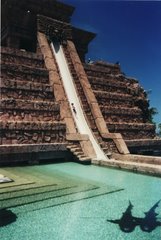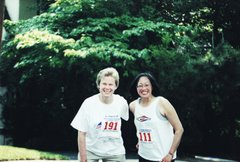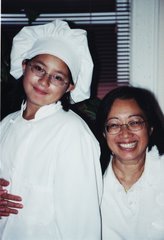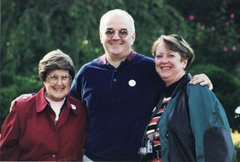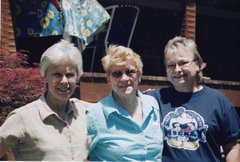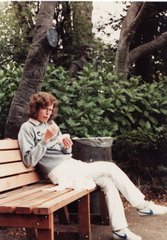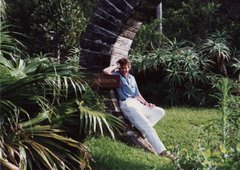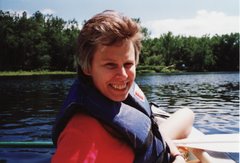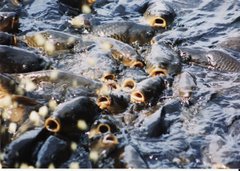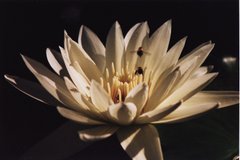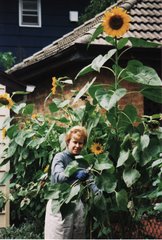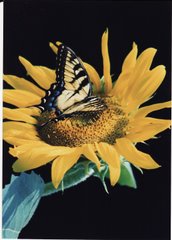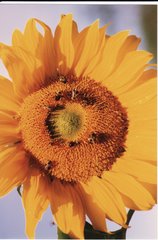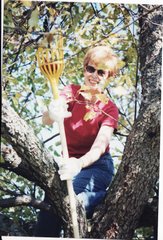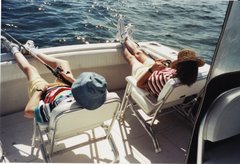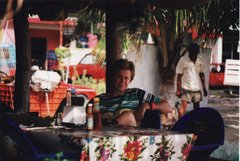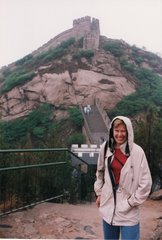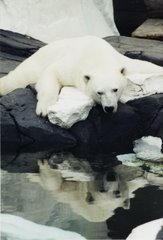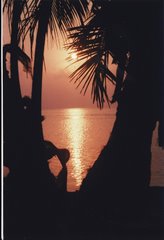

I found this very informative piece at Thanksgiving on the Net and thought I would share it with you.
The Pilgrims, who celebrated the first thanksgiving in America, were fleeing religious persecution in their native England. In 1609 a group of Pilgrims left England for the religious freedom in Holland where they lived and prospered. After a few years their children were speaking Dutch and had become attached to the dutch way of life. This worried the Pilgrims. They considered the Dutch frivolous and their ideas a threat to their children's education and morality.
So they decided to leave Holland and travel to the New World. Their trip was financed by a group of English investors, the Merchant Adventurers. It was agreed that the Pilgrims would be given passage and supplies in exchange for their working for their backers for 7 years.
On Sept. 6, 1620 the Pilgrims set sail for the New World on a ship called the Mayflower. They sailed from Plymouth, England and aboard were 44 Pilgrims, who called themselves the "Saints", and 66 others ,whom the Pilgrims called the "Strangers."
The long trip was cold and damp and took 65 days. Since there was the danger of fire on the wooden ship, the food had to be eaten cold. Many passengers became sick and one person died by the time land was sighted on November 10th.
The long trip led to many disagreements between the "Saints" and the "Strangers". After land was sighted a meeting was held and an agreement was worked out, called the Mayflower Compact, which guaranteed equality and unified the two groups. They joined together and named themselves the "Pilgrims."Although they had first sighted land off Cape Cod they did not settle until they arrived at Plymouth, which had been named by Captain John Smith in 1614. It was there that the Pilgrims decide to settle. Plymouth offered an excellent harbor. A large brook offered a resource for fish. The Pilgrims biggest concern was attack by the local Native American Indians. But the Patuxets were a peaceful group and did not prove to be a threat.
The first winter was devastating to the Pilgrims. The cold, snow and sleet was exceptionally heavy, interfering with the workers as they tried to construct their settlement. March brought warmer weather and the health of the Pilgrims improved, but many had died during the long winter. Of the 110 Pilgrims and crew who left England, less that 50 survived the first winter.
On March 16, 1621 , what was to become an important event took place, an Indian brave walked into the Plymouth settlement. The Pilgrims were frightened until the Indian called out "Welcome" (in English!).
His name was Samoset and he was an Abnaki Indian. He had learned English from the captains of fishing boats that had sailed off the coast. After staying the night Samoset left the next day. He soon returned with another Indian named Squanto who spoke better English than Samoset. Squanto told the Pilgrims of his voyages across the ocean and his visits to England and Spain. It was in England where he had learned English.
Squanto's importance to the Pilgrims was enormous and it can be said that they would not have survived without his help. It was Squanto who taught the Pilgrims how to tap the maple trees for sap. He taught them which plants were poisonous and which had medicinal powers. He taught them how to plant the Indian corn by heaping the earth into low mounds with several seeds and fish in each mound. The decaying fish fertilized the corn. He also taught them to plant other crops with the corn.
The harvest in October was very successful and the Pilgrims found themselves with enough food to put away for the winter. There was corn, fruits and vegetables, fish to be packed in salt, and meat to be cured over smoky fires.
The Pilgrims had much to celebrate, they had built homes in the wilderness, they had raised enough crops to keep them alive during the long coming winter, they were at peace with their Indian neighbors. They had beaten the odds and it was time to celebrate.
The Pilgrim Governor William Bradford proclaimed a day of thanksgiving to be shared by all the colonists and the neighboring Native Americans. They invited Squanto and the other Indians to join them in their celebration. Their chief, Massasoit, and 90 braves came to the celebration which lasted for 3 days. They played games, ran races, marched and played drums. The Indians demonstrated their skills with the bow and arrow and the Pilgrims demonstrated their musket skills. Exactly when the festival took place is uncertain, but it is believed the celebration took place in mid-October.
The following year the Pilgrims harvest was not as bountiful, as they were still unused to growing the corn. During the year they had also shared their stored food with newcomers and the Pilgrims ran short of food.
The 3rd year brought a spring and summer that was hot and dry with the crops dying in the fields. Governor Bradford ordered a day of fasting and prayer, and it was soon thereafter that the rain came. To celebrate - November 29th of that year was proclaimed a day of thanksgiving.
This date is believed to be the real true beginning of the present day Thanksgiving Day
The custom of an annually celebrated thanksgiving, held after the harvest, continued through the years. During the American Revolution (late 1770's) a day of national thanksgiving was suggested by the Continental Congress.
In 1817 New York State had adopted Thanksgiving Day as an annual custom. By the middle of the 19th century many other states also celebrated a Thanksgiving Day. In 1863 President Abraham Lincoln appointed a national day of thanksgiving. Since then each president has issued a Thanksgiving Day proclamation, usually designating the fourth Thursday of each November as the holiday.
 Rolling out the dough to 1/8 inch thickness happens pretty quickly, again parchment paper helps to keep the mess to a minium. Also, I found using a pizza wheel makes cutting them a breeze
Rolling out the dough to 1/8 inch thickness happens pretty quickly, again parchment paper helps to keep the mess to a minium. Also, I found using a pizza wheel makes cutting them a breeze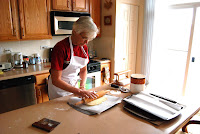 Placing the dough on the baking sheet with enough space so they don;t touch each other...they get smaller once you start pinching the edges
Placing the dough on the baking sheet with enough space so they don;t touch each other...they get smaller once you start pinching the edges Here is where you have to be careful, if the jelly smears to the edges, you can't pinch it closed. Most of these cookies came open, so next time I will make a bigger square and pinch harder..I was very gentle with these.
Here is where you have to be careful, if the jelly smears to the edges, you can't pinch it closed. Most of these cookies came open, so next time I will make a bigger square and pinch harder..I was very gentle with these. If you take the cookies off the tray right out of the oven, any spillage will easily be left behind and the cookie will look much better for it
If you take the cookies off the tray right out of the oven, any spillage will easily be left behind and the cookie will look much better for it

 This is a Chuck Roast that we are using to prepare a pot roast by braising. Notice how the edge has some nice fat for flavoring the sauce and in the middle there is a little fat marbling..but not too much; otherwise the dish would get greasy.
This is a Chuck Roast that we are using to prepare a pot roast by braising. Notice how the edge has some nice fat for flavoring the sauce and in the middle there is a little fat marbling..but not too much; otherwise the dish would get greasy. We dried it first with a paper towel and seasoned with salt and pepper
We dried it first with a paper towel and seasoned with salt and pepper Then placed it into a deep pot with a little oil for browning on both sides
Then placed it into a deep pot with a little oil for browning on both sides Once that was done, we added some diced onions and sauteed until golden brown
Once that was done, we added some diced onions and sauteed until golden brown We then added some demi-glace that had been thinned with stock to the pot; we deglazed the pan with wine and simmered for a bit before putting the roast back in
We then added some demi-glace that had been thinned with stock to the pot; we deglazed the pan with wine and simmered for a bit before putting the roast back in
 We added some fresh cut up carrots, celery and mushrooms
We added some fresh cut up carrots, celery and mushrooms the liquid should only come up about 2/3rds of the meat otherwise it will boil; it should just simmer in the liquid and have the top exposed. We did cover the pot.
the liquid should only come up about 2/3rds of the meat otherwise it will boil; it should just simmer in the liquid and have the top exposed. We did cover the pot. After several hours we fork tested the meat and then removed it for slicing. You could just pull it apart in chunks or smaller pieces...we opted for slices.
After several hours we fork tested the meat and then removed it for slicing. You could just pull it apart in chunks or smaller pieces...we opted for slices. We removed the vegetables from the liquid and reduced what was there to about half; prepared matching amounts of flour and butter in a paste form and stirred it into the liquid to thicken
We removed the vegetables from the liquid and reduced what was there to about half; prepared matching amounts of flour and butter in a paste form and stirred it into the liquid to thicken

 Then drizzled it over the sliced pot roast. It was divine!
Then drizzled it over the sliced pot roast. It was divine! We also made blueberry almond muffins. Here you see the dry ingredients and the frozen blueberries waiting for the wet ingredients to be added.
We also made blueberry almond muffins. Here you see the dry ingredients and the frozen blueberries waiting for the wet ingredients to be added. First you coat the berries so they don't bleed all through the batter
First you coat the berries so they don't bleed all through the batter The wet ingredients need to be blended before adding to the dry...
The wet ingredients need to be blended before adding to the dry... Then just combine it, as soon as you see a blue color in the dough, you are done
Then just combine it, as soon as you see a blue color in the dough, you are done We used an ice cream scoop to put the batter in the baking pans...we sprayed the pans with a baking oil coating to prevent sticking and it worked just fine. After they are in the oven for half the estimated time, they must be turned so they all cook evenly.
We used an ice cream scoop to put the batter in the baking pans...we sprayed the pans with a baking oil coating to prevent sticking and it worked just fine. After they are in the oven for half the estimated time, they must be turned so they all cook evenly. We have painted the glaze on them and now just add a few slivered almonds and it is done!
We have painted the glaze on them and now just add a few slivered almonds and it is done! So...you thought salad was easy? Here we are putting hardboiled eggs through a potato ricer to get small even pieces of egg for the tossed salad
So...you thought salad was easy? Here we are putting hardboiled eggs through a potato ricer to get small even pieces of egg for the tossed salad We cut up several slices of bread, sprinkled them with oil and some herbs
We cut up several slices of bread, sprinkled them with oil and some herbs Spread the concoction evenly on a baking pan and roasted for 10 minutes or so at 350 degrees
Spread the concoction evenly on a baking pan and roasted for 10 minutes or so at 350 degrees Here is what we got! I may never buy croutons again!
Here is what we got! I may never buy croutons again! here's the rest of the salad ingredients
here's the rest of the salad ingredients and there it is in a pretty bowl.
and there it is in a pretty bowl. I made the dressing, but since I have no pictures. I won't bore you with the items that went into it. Suffice to say it was great.
I made the dressing, but since I have no pictures. I won't bore you with the items that went into it. Suffice to say it was great. Then of course we had to make a really nice dessert...what is better than chocolate souffle? We buttered the ramekins and then sprinkled sugar in each one, it helps the souffle come away from the dish when it bakes. We cleaned off the first 1/4 inch of the inside so the souffle did not get stuck when trying to rise.
Then of course we had to make a really nice dessert...what is better than chocolate souffle? We buttered the ramekins and then sprinkled sugar in each one, it helps the souffle come away from the dish when it bakes. We cleaned off the first 1/4 inch of the inside so the souffle did not get stuck when trying to rise. The egg yolks, sugar cream need to be blended
The egg yolks, sugar cream need to be blended The bittersweet chocolate and cream and butter need to be heated and blended gently.
The bittersweet chocolate and cream and butter need to be heated and blended gently. Then poured slowly into the egg mixture so as not to cook the eggs
Then poured slowly into the egg mixture so as not to cook the eggs Then all added back to the pan and cooked some more
Then all added back to the pan and cooked some more Until it is thickened a bit
Until it is thickened a bit We whip the egg whites and sugar to get a nice froth
We whip the egg whites and sugar to get a nice froth
 They say if you can turn the pan upside down and it doesn't come out, it is the right consistency
They say if you can turn the pan upside down and it doesn't come out, it is the right consistency

 Fold the rest in to get a nice light mixture
Fold the rest in to get a nice light mixture Here is what they look like before going into the oven
Here is what they look like before going into the oven And thisis the finished product
And thisis the finished product
 Now, I know we all can make mashed potatoes...but not like this! First cut them into about 1 inch squares, they cook pretty quickly this way
Now, I know we all can make mashed potatoes...but not like this! First cut them into about 1 inch squares, they cook pretty quickly this way When cooked push them through a potato ricer
When cooked push them through a potato ricer Here is what it looks like before any butter or cream/milk
Here is what it looks like before any butter or cream/milk melt the butter in the milk
melt the butter in the milk salt and pepper the riced potatoes then add the milk butter mixture and stir. In moments you will have teh best mashed potatoes you have ever had.
salt and pepper the riced potatoes then add the milk butter mixture and stir. In moments you will have teh best mashed potatoes you have ever had. Next we did steaks. I actually had this down pretty good before this class, but I learned that you shoudl blot the meat with paper towels first, then oil and season with salt and pepper
Next we did steaks. I actually had this down pretty good before this class, but I learned that you shoudl blot the meat with paper towels first, then oil and season with salt and pepper
 Place them on the grill facing 10 o'clock to sear, after a few minutes just point them towards
Place them on the grill facing 10 o'clock to sear, after a few minutes just point them towards
 See.. pretty cool huh?
See.. pretty cool huh? Here they are all done
Here they are all done Here they are ready for serving
Here they are ready for serving This is Jill my cook-mate for the last three days...what a great time we both had!
This is Jill my cook-mate for the last three days...what a great time we both had! Here is my lunch plate of steak, mashed potatoes, pot roast and string beans
Here is my lunch plate of steak, mashed potatoes, pot roast and string beans
